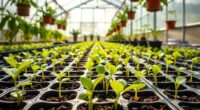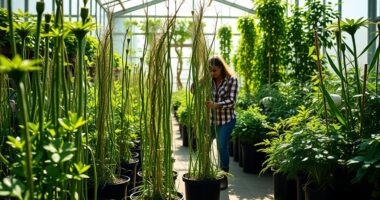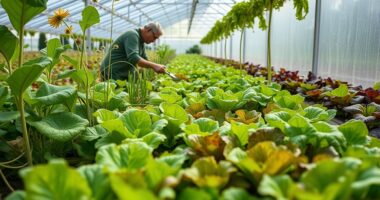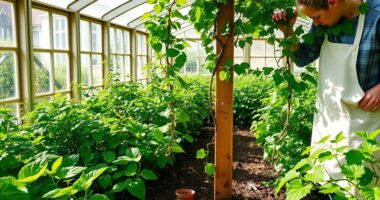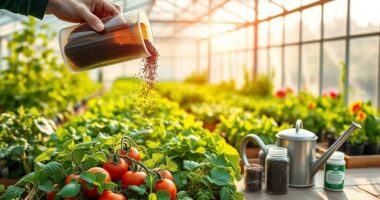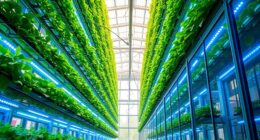To succeed in greenhouse propagation, focus on selecting healthy seeds and matching soil temperature and moisture for germination. Use cuttings with proper tools and rooting hormones, and maintain humidity for best results. Graft and layer plants carefully, ensuring good cambial contact and proper support. Dividing mature plants is also effective if done gently and at the right time. Keep environmental conditions ideal and organized; exploring these techniques further will improve your success rate.
Key Takeaways
- Select healthy, vigorous plant material and use well-draining media to improve propagation success.
- Use proper sowing techniques: match soil temperature, plant at correct depth, and maintain consistent moisture.
- Employ effective cutting and grafting methods with sterilized tools, rooting hormones, and proper alignment for strong unions.
- Utilize layering and division for woody plants, ensuring proper moisture, healthy material, and careful handling during separation.
- Maintain optimal post-propagation conditions: regulate humidity, protect from pests, and provide balanced fertilization for healthy growth.
Seed Sowing Strategies for Optimal Germination
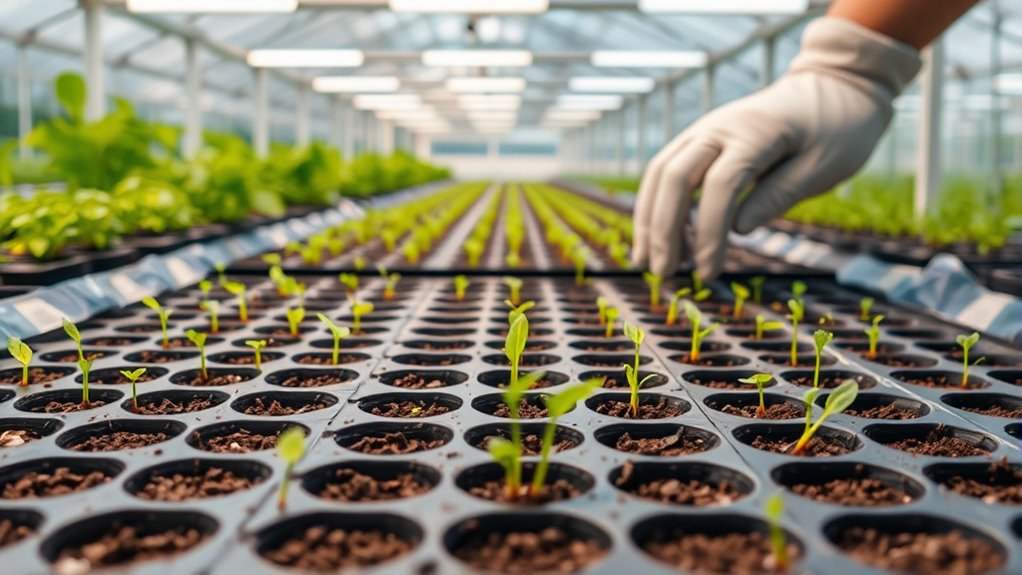
To achieve the best germination results, it’s essential to follow effective seed sowing strategies. Start by preparing the soil properly; loosen it and mix in organic matter to guarantee good drainage and nutrients. Growing conditions such as temperature and light are crucial for seed sprouting success. Make sure the soil’s temperature matches the seed’s requirements for ideal sprouting. When sowing, plant seeds at the correct depth, usually twice as deep as the seed’s size. Establish a consistent watering schedule, keeping the soil evenly moist but not waterlogged. Use a spray bottle or gentle watering method to avoid displacing seeds. Cover the containers with a clear lid or plastic wrap to maintain humidity. Regularly check moisture levels and adjust watering as needed. These steps ensure healthy germination and strong seedling development from the start.
Propagating Plants Through Cuttings
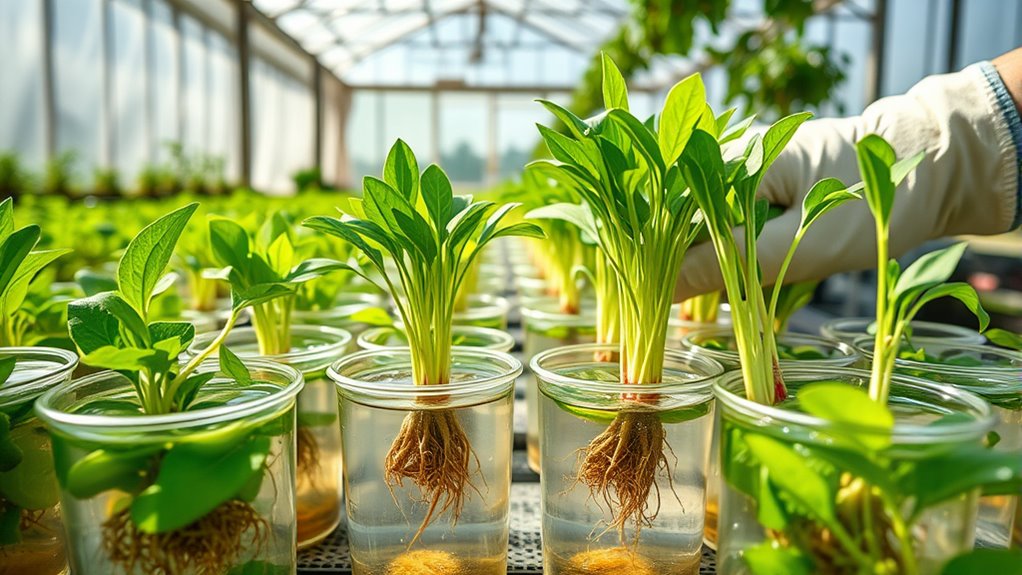
Propagating plants through cuttings offers a straightforward way to produce new plants that are genetically identical to the parent. To succeed, select healthy, disease-free stems and use sharp cutting tools to make clean cuts. Dip the cuttings in rooting hormones to encourage root development. Keep the soil moist and provide indirect light to boost rooting success. Using proper tools minimizes damage and speeds healing, increasing your chances of success. Proper plant care during propagation is essential for healthy root development. Additionally, choosing the right tools can significantly improve your success rate. Ensuring you understand the plant’s specific needs can further enhance propagation success rates. For optimal results, consider the support hours of your local garden centers or greenhouses, especially during peak planting seasons. Incorporating techniques like mindfulness practices can help maintain patience and focus during the propagation process, leading to better results.
Grafting and Budding Techniques for Greenhouse Plants
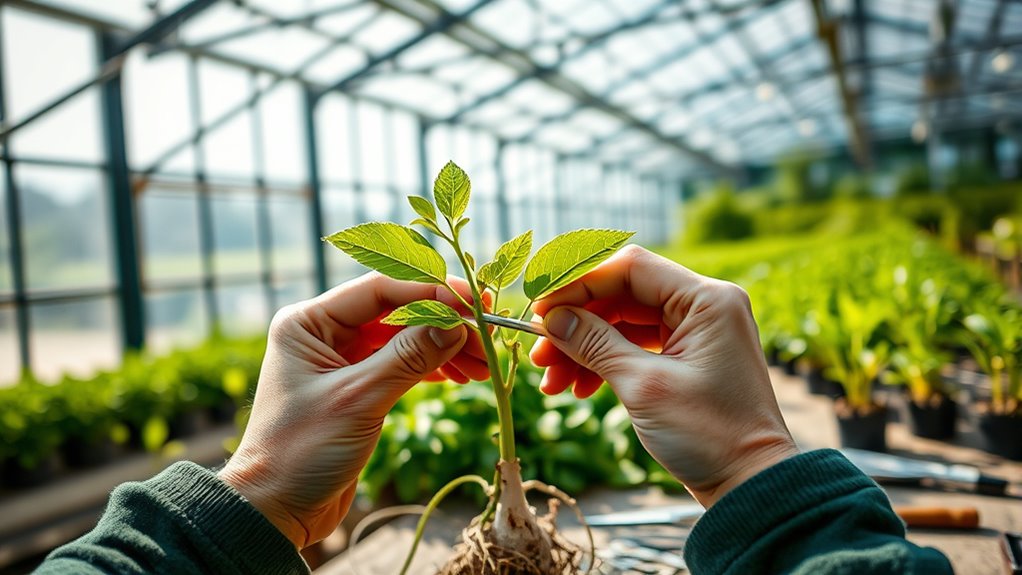
When grafting and budding, you need to choose compatible plants to guarantee successful union. Using proper techniques helps maximize the chances of a strong graft, while attentive post-propagation care keeps your plants healthy. Developing self-awareness can help you better understand your gardening preferences and improve your overall horticultural skills. Recognizing the importance of plant compatibility is crucial for a successful graft or bud union, as it ensures the health and longevity of your propagated plants. Incorporating hydrotherapy principles, such as maintaining optimal water conditions and temperature, can also support plant healing and growth during the propagation process. Additionally, utilizing wall organization systems can help you keep your propagation tools and supplies organized, making the process more efficient. Mastering these steps will improve your greenhouse’s overall success rate.
Selecting Compatible Plants
Have you ever wondered how to guarantee successful grafting and budding in your greenhouse? Choosing compatible plants is key. Select rootstocks and scions with similar growth habits and genetic compatibility to assure strong unions. Incorporating leadership skills such as careful planning and strategic decision-making can further improve your success rate. Consider how companion planting can support pest management, making the environment healthier for your grafted plants. Avoid pairing species with differing water, light, or nutrient needs, as this can hinder success. Research the compatibility of specific plant varieties beforehand, and always inspect both parts for health and disease. Proper matching reduces graft failure and promotes vigorous growth. Additionally, understanding celebrity lifestyle insights can inspire innovative approaches to garden design and plant care, encouraging a more personalized and successful greenhouse environment. Being aware of Vetted – Flat Iron Bike options can also serve as a reminder to incorporate sustainable practices into your gardening routine, such as eco-friendly tools and techniques. Ensuring you select appropriate propagation materials can further enhance your success rate and plant health. Maintaining a growth mindset allows you to adapt and learn from any challenges encountered during propagation, increasing overall success.
Proper Grafting Technique
Mastering proper grafting and budding techniques is essential for ensuring strong, healthy plant unions in your greenhouse. The key to success lies in creating a solid graft union by ensuring good cambial contact between the scion and rootstock. To do this, make precise cuts that align the cambial layers, promoting ideal tissue fusion. Clean, sharp tools are crucial for smooth, accurate cuts, reducing damage and infection risk. When joining the parts, secure them firmly with grafting tape or clips to maintain consistent contact. Avoid gaps or misalignment, as these can prevent successful grafting. Proper technique leads to quicker healing, stronger unions, and healthier plants. Additionally, using quality modern tools can further improve your grafting precision and outcomes. Employing proper sterilization methods for your tools and work area also minimizes the risk of disease transmission, ensuring healthier plant development. Incorporating advanced techniques can further optimize your success rate and improve overall plant vigor. Maintaining proper soil conditions, such as proper pH levels and organic matter, can support overall plant health and grafting success while also promoting vigorous growth of the grafted plants.
Post-Propagation Care
After completing a successful graft or bud, proper post-propagation care guarantees your plants heal quickly and develop strong unions. Make certain you keep the grafted area protected from stress and environmental fluctuations.
Regular fertilizer application provides essential nutrients that support healing and growth, but avoid over-fertilizing, which can cause stress.
Monitor your plants closely for pests; effective pest management prevents damage that could hinder union development. Use gentle, targeted treatments and remove any infested leaves promptly.
Maintain proper humidity and airflow to reduce disease risk. Keep the plants in a stable environment, avoiding extreme temperatures.
Consistent care, combined with attentive pest control and balanced fertilization, ensures your grafts and buds establish strong, healthy connections for successful greenhouse propagation.
Layering Methods to Encourage Root Development
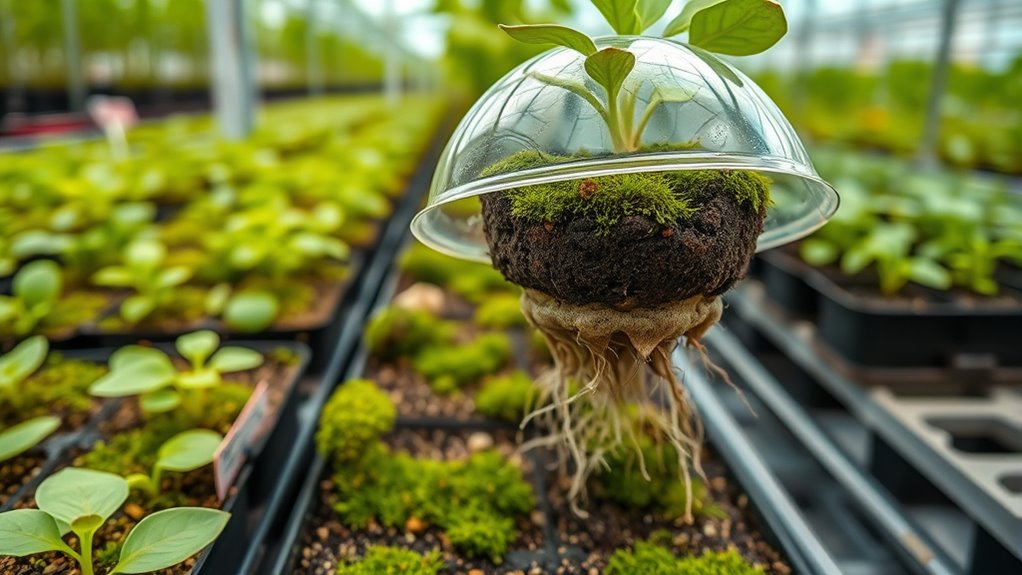
Layering is a reliable propagation method that encourages root development while the plant remains attached to its parent.
Air layering involves creating a small wound on the stem, wrapping it with moist sphagnum moss, and sealing it with plastic to promote root growth. This technique works well for woody plants and produces mature roots quickly.
Compound layering, on the other hand, involves bending a low-growing branch to the ground and covering part of it with soil, encouraging roots to form along that section. Once rooted, you can sever the new plant from the parent.
Both methods are effective for propagating plants that are difficult to root from cuttings, and they help maintain the parent plant’s health during the process. Proper moisture and protection are key to success with layering techniques.
Propagation Using Divisions and Offsets
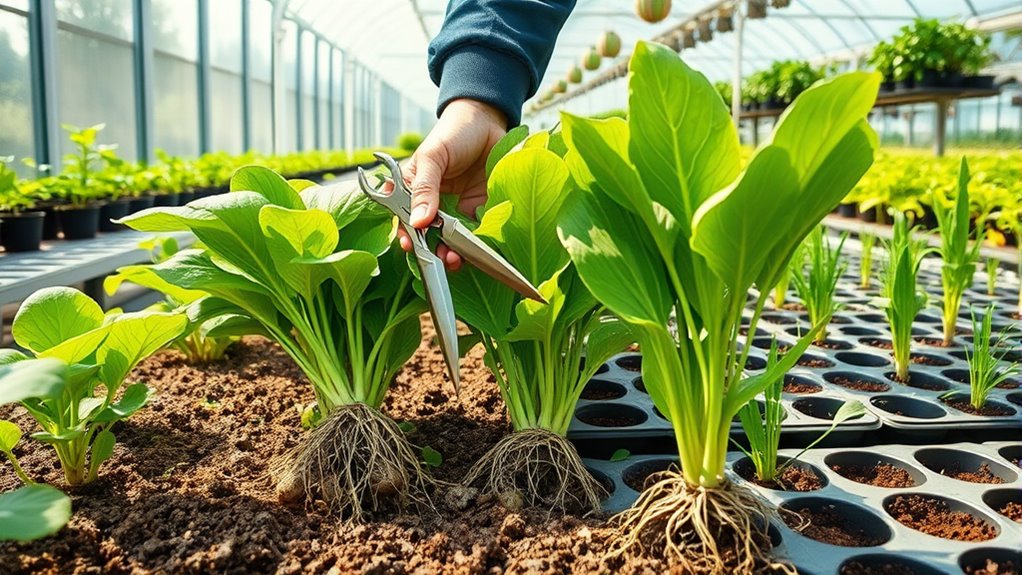
To succeed with divisions and offsets, you need to start with healthy, vigorous plant material. Carefully select plants that show strong growth and are free from disease or damage.
Use proper division techniques to guarantee each section has enough roots and shoots for successful establishment.
Selecting Healthy Plant Material
Choosing healthy plant material is essential for successful propagation through divisions and offsets. You want to select plants with vigorous growth, strong healthy roots, and no signs of pests or disease.
Inspect the base of the plant for any damage or discoloration that could hinder growth. Look for roots that are firm and well-developed, indicating good health. Avoid plants with wilting leaves or evidence of pest infestation, as these issues can spread during propagation.
To ensure pest prevention, choose plants with no visible insects or eggs. Additionally, select material that has recently shown healthy growth, increasing your chances of successful propagation.
Being selective helps you establish robust new plants and minimizes problems down the line, setting the foundation for greenhouse success.
Proper Division Techniques
Proper division techniques involve carefully separating plants into manageable sections to guarantee healthy new growth. When dividing, use clean tools and ensure each section has enough roots and foliage for survival. Before dividing, improve soil conditions with suitable amendments to provide essential nutrients and promote vigorous growth. This also helps prevent disease transmission, supporting pest management efforts.
Handle roots gently to minimize stress and damage. Remove any diseased or weak parts to maintain plant health. After division, replant the sections into prepared soil, ensuring proper spacing.
Regularly monitor for pests and apply integrated pest management strategies as needed. Proper division not only encourages robust development but also maintains the overall health of your greenhouse plants, making your propagation efforts more successful.
Selecting the Right Medium and Environment for Propagation
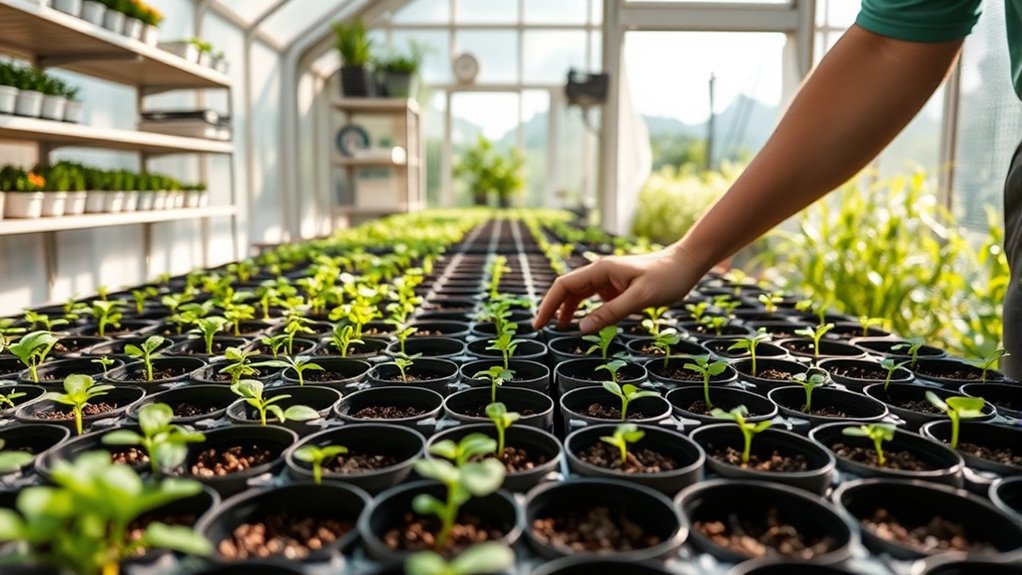
Selecting the right medium and environment is essential for successful propagation because it directly influences root development and plant health. Your choice impacts root zone management and humidity control, which are key to healthy growth.
Choosing the right medium and environment is vital for healthy root growth and plant success.
Consider these factors:
- Use a well-draining medium like a mix of peat, perlite, and vermiculite to prevent waterlogging.
- Maintain ideal humidity levels to avoid damping-off and encourage root formation.
- Guarantee consistent moisture without overwatering, balancing root zone management for strong roots.
Frequently Asked Questions
How Can I Prevent Diseases During Propagation?
To prevent diseases during propagation, you should focus on pathogen control and disease prevention measures. Keep your tools and surfaces sanitized, use sterile materials, and avoid overwatering to reduce humidity that fosters pathogens.
Guarantee proper airflow and maintain a clean environment to minimize disease risks. Regularly inspect your plants for early signs of infection, and remove infected material immediately.
These practices help create a healthy environment, reducing disease spread and promoting successful propagation.
What Are the Best Tools for Greenhouse Propagation?
Think of your greenhouse as a symphony, where the right tools set the perfect tone. You’ll want reliable propagation tools like sharp pruners, dibbers, and watering cans to handle delicate tasks.
Seedling trays are essential for starting healthy plants, providing uniform space and proper drainage.
Using quality propagation tools and sturdy seedling trays guarantees your plants grow strong from the very beginning, leading to a flourishing greenhouse performance.
How Do Temperature Fluctuations Affect Propagation Success?
Temperature fluctuations can considerably impact your propagation success by disrupting the delicate balance needed for seed germination and root development. You should focus on temperature regulation to maintain consistent warmth, preventing stress on your plants.
Humidity control is equally essential; it helps stabilize moisture levels, reducing the risk of damping-off and mold.
Can Propagation Techniques Vary for Different Plant Species?
Yes, propagation techniques can vary for different plant species. You should consider species-specific strategies and genetic considerations to optimize success.
Some plants require specific rooting hormones, temperature ranges, or light conditions, while others need different methods like cuttings, seeds, or grafting. Tailoring your approach guarantees healthy growth and better yields.
Taking into account each plant’s unique needs and genetic traits is essential for the best propagation results.
How Long Does Each Propagation Method Typically Take?
When you ask about propagation timing, it varies based on the method and plant species. Typically, using rooting hormones can speed up root development, reducing propagation time.
For cuttings, expect roots to form in 2-8 weeks, while seed germination can take 1-4 weeks. Factors like temperature, humidity, and plant type influence these timelines, so monitor conditions carefully to guarantee successful propagation.
Conclusion
By mastering these propagation techniques, you’re planting the seeds of growth and resilience. Each method is a thread in the tapestry of your greenhouse’s success, symbolizing your dedication and nurturing spirit. As you tend to your plants, remember you’re cultivating more than greenery—you’re fostering life, hope, and new beginnings. With patience and care, your greenhouse will flourish, a vibrant affirmation to your passion and perseverance.

